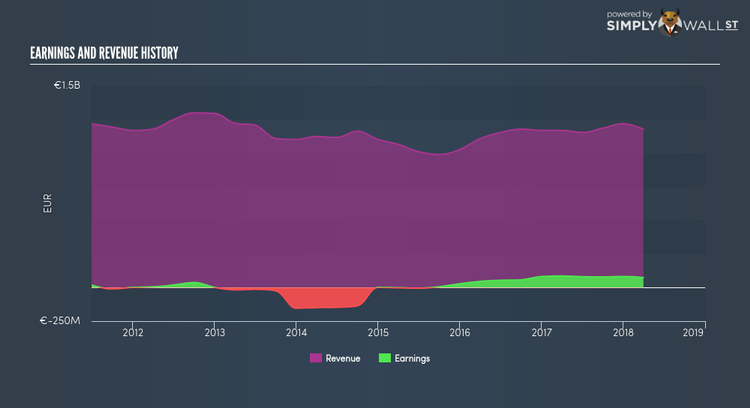Koenig & Bauer AG’s (FRA:SKB) Earnings Dropped -13.58%, How Did It Fare Against The Industry?

When Koenig & Bauer AG’s (DB:SKB) announced its latest earnings (31 March 2018), I wanted to understand how these figures stacked up against its past performance. The two benchmarks I used were Koenig & Bauer’s average earnings over the past couple of years, and its industry performance. These are useful yardsticks to help me gauge whether or not SKB actually performed well. Below is a quick commentary on how I see SKB has performed. View our latest analysis for Koenig & Bauer
Commentary On SKB’s Past Performance
For the purpose of this commentary, I like to use data from the most recent 12 months, which either annualizes the most recent 6-month earnings update, or in some cases, the most recent annual report is already the latest available financial data. This method allows me to assess many different companies on a similar basis, using the latest information. For Koenig & Bauer, its most recent bottom-line (trailing twelve month) is €73.80M, which compared to the prior year’s level, has plunged by -13.58%. Since these figures may be somewhat short-term, I have estimated an annualized five-year figure for SKB’s earnings, which stands at €3.28M This means despite the fact that earnings declined against last year, over a longer period of time, Koenig & Bauer’s profits have been increasing on average.
What’s the driver of this growth? Let’s take a look at if it is merely attributable to an industry uplift, or if Koenig & Bauer has experienced some company-specific growth. Over the last few years, Koenig & Bauer grew bottom-line, while its top-line declined, by successfully controlling its costs. This brought about to a margin expansion and profitability over time. Scanning growth from a sector-level, the DE machinery industry has been growing its average earnings by double-digit 22.53% over the previous twelve months, and a more subdued 5.81% over the previous five years. This means whatever tailwind the industry is benefiting from, Koenig & Bauer has not been able to reap as much as its industry peers.
What does this mean?
Though Koenig & Bauer’s past data is helpful, it is only one aspect of my investment thesis. Companies that are profitable, but have volatile earnings, can have many factors impacting its business. You should continue to research Koenig & Bauer to get a better picture of the stock by looking at:
Future Outlook: What are well-informed industry analysts predicting for SKB’s future growth? Take a look at our free research report of analyst consensus for SKB’s outlook.
Financial Health: Is SKB’s operations financially sustainable? Balance sheets can be hard to analyze, which is why we’ve done it for you. Check out our financial health checks here.
Other High-Performing Stocks: Are there other stocks that provide better prospects with proven track records? Explore our free list of these great stocks here.
NB: Figures in this article are calculated using data from the trailing twelve months from 31 March 2018. This may not be consistent with full year annual report figures.
To help readers see pass the short term volatility of the financial market, we aim to bring you a long-term focused research analysis purely driven by fundamental data. Note that our analysis does not factor in the latest price sensitive company announcements.
The author is an independent contributor and at the time of publication had no position in the stocks mentioned.

 Yahoo Finance
Yahoo Finance 
